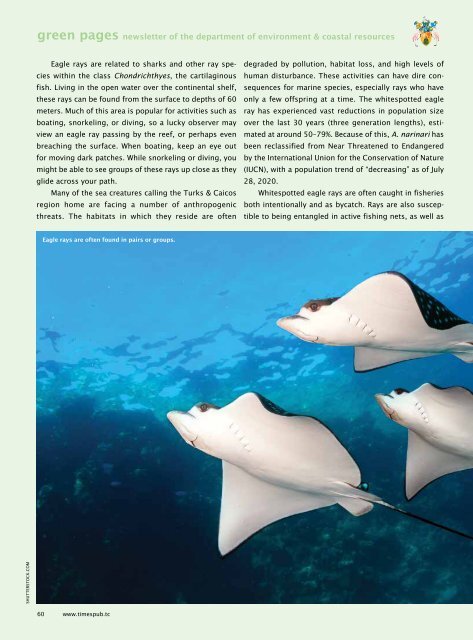Times of the Islands Summer 2022
Presents the "soul of the Turks & Caicos Islands" with in-depth features about local people, culture, history, environment, real estate, businesses, resorts, restaurants and activities.
Presents the "soul of the Turks & Caicos Islands" with in-depth features about local people, culture, history, environment, real estate, businesses, resorts, restaurants and activities.
You also want an ePaper? Increase the reach of your titles
YUMPU automatically turns print PDFs into web optimized ePapers that Google loves.
green pages newsletter <strong>of</strong> <strong>the</strong> department <strong>of</strong> environment & coastal resources<br />
Eagle rays are related to sharks and o<strong>the</strong>r ray species<br />
within <strong>the</strong> class Chondrichthyes, <strong>the</strong> cartilaginous<br />
fish. Living in <strong>the</strong> open water over <strong>the</strong> continental shelf,<br />
<strong>the</strong>se rays can be found from <strong>the</strong> surface to depths <strong>of</strong> 60<br />
meters. Much <strong>of</strong> this area is popular for activities such as<br />
boating, snorkeling, or diving, so a lucky observer may<br />
view an eagle ray passing by <strong>the</strong> reef, or perhaps even<br />
breaching <strong>the</strong> surface. When boating, keep an eye out<br />
for moving dark patches. While snorkeling or diving, you<br />
might be able to see groups <strong>of</strong> <strong>the</strong>se rays up close as <strong>the</strong>y<br />
glide across your path.<br />
Many <strong>of</strong> <strong>the</strong> sea creatures calling <strong>the</strong> Turks & Caicos<br />
region home are facing a number <strong>of</strong> anthropogenic<br />
threats. The habitats in which <strong>the</strong>y reside are <strong>of</strong>ten<br />
degraded by pollution, habitat loss, and high levels <strong>of</strong><br />
human disturbance. These activities can have dire consequences<br />
for marine species, especially rays who have<br />
only a few <strong>of</strong>fspring at a time. The whitespotted eagle<br />
ray has experienced vast reductions in population size<br />
over <strong>the</strong> last 30 years (three generation lengths), estimated<br />
at around 50–79%. Because <strong>of</strong> this, A. narinari has<br />
been reclassified from Near Threatened to Endangered<br />
by <strong>the</strong> International Union for <strong>the</strong> Conservation <strong>of</strong> Nature<br />
(IUCN), with a population trend <strong>of</strong> “decreasing” as <strong>of</strong> July<br />
28, 2020.<br />
Whitespotted eagle rays are <strong>of</strong>ten caught in fisheries<br />
both intentionally and as bycatch. Rays are also susceptible<br />
to being entangled in active fishing nets, as well as<br />
Eagle rays are <strong>of</strong>ten found in pairs or groups.<br />
SHUTTERSTOCK.COM<br />
60 www.timespub.tc
















